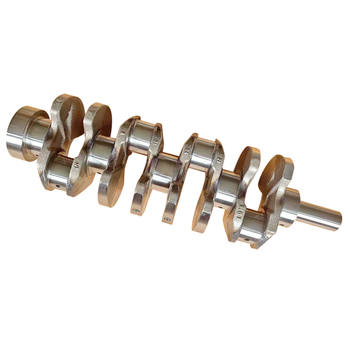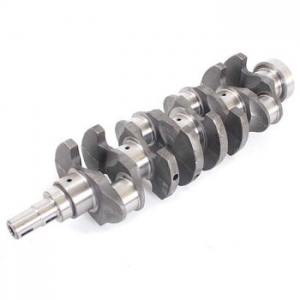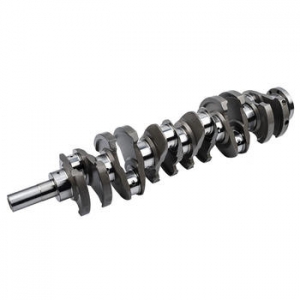The Hidden Cost of Engine Noise: A Manufacturer\'s Guide to Identifying Crankshaft Imbalance Issues
Engine noise is often perceived as an unavoidable byproduct of combustion, a mechanical symphony that simply signifies operation. However, for manufacturers, certain types of engine noise can be far more than just an auditory nuisance; they can be a harbinger of significant underlying issues, particularly those stemming from crankshaft imbalance. To be honest, the true cost of these imbalances extends far beyond immediate warranty claims or repair expenses. They erode brand reputation, diminish customer satisfaction, and can lead to catastrophic failures down the line. This guide aims to illuminate these hidden costs and provide a comprehensive framework for identifying crankshaft imbalance issues, ensuring the longevity and performance of your engines.
Understanding the Symphony of Silence: Why Engine Noise Matters to Manufacturers
In the automotive and industrial sectors, the pursuit of quieter, smoother-running engines is relentless. This isn't merely about luxury or driver comfort; it's fundamentally about engineering integrity and perceived quality. When we talk about engine noise, we're not just referring to the general hum or roar. We're focusing on specific, often irregular, sounds: persistent knocking, excessive vibration, or a pronounced thrumming that deviates from the expected operational acoustics. These auditory cues are the first, and often most overlooked, indicators of internal stress and component wear.
The "hidden cost" aspect truly comes into play here. A subtle imbalance in a crankshaft might not immediately cause a breakdown, but it initiates a cascade of detrimental effects. It accelerates wear on bearings, connecting rods, and even the engine block itself due to increased dynamic loads. This leads to premature component failure, increased warranty claims, and ultimately, a tarnished brand image. Is the initial saving from not meticulously balancing every crankshaft truly worth the potential multi-million-dollar recall or the irreversible damage to customer trust? Many experts agree that investing in robust balancing processes upfront is a non-negotiable aspect of modern engine manufacturing. Our company has seen firsthand how a proactive approach to noise and vibration analysis can save immense resources in the long run.
The Unseen Culprit: Delving into Crankshaft Imbalance
At the heart of an engine's rotational dynamics lies the crankshaft, converting the linear motion of pistons into rotational energy. Its precise balance is paramount. Any deviation, however slight, from this ideal balance can lead to significant vibrational forces. These imbalances can be static, dynamic, or a combination of both. A static imbalance occurs when the center of gravity of the crankshaft is not on its axis of rotation, causing a heavy spot that creates a force in one direction. Dynamic imbalance, more complex and common, involves an uneven distribution of mass along the length of the crankshaft, leading to a wobbling or rocking motion as it rotates.
Interestingly enough, these imbalances can arise from various stages of the manufacturing process. Material inconsistencies, machining tolerances, casting defects, or even improper assembly can contribute. Even a minuscule amount of excess material or a slight deviation in geometry can translate into substantial centrifugal forces at high RPMs. Think about it: a crankshaft spinning at 6,000 RPM with even a few grams of imbalance can generate forces equivalent to several kilograms. This constant, rhythmic pounding transmits through the entire engine structure, manifesting as the very engine noise we're discussing. Understanding these root causes is the first step in developing effective identification and mitigation strategies.

Early Warning Signs: Detecting Imbalance Before Catastrophe Strikes
Identifying crankshaft imbalance isn't always about waiting for a catastrophic failure. There are several tell-tale signs that manufacturers and quality control teams should be acutely aware of, both during the production phase and through post-production testing. The most obvious, of course, is the aforementioned excessive engine noise – a distinct hum, whine, or knocking that isn't characteristic of a properly functioning engine. This noise often intensifies with RPM.
Beyond auditory cues, excessive vibration is a critical indicator. This can be felt throughout the engine block, transmitted to the chassis, and even noticeable through the steering wheel or vehicle cabin. In my experience, a consistent, high-frequency vibration that doesn't dissipate after engine warm-up is a red flag. Oil analysis can also provide clues; increased metallic particles, particularly bearing material, can suggest accelerated wear due to imbalance-induced stress. Furthermore, premature wear on engine mounts, accessory belts, and even exhaust system components can point towards an underlying vibration issue originating from the crankshaft. It's worth noting that these symptoms might initially be subtle, but they invariably worsen over time as the imbalance continues to stress components.
Subtle Indicators to Monitor:
- Unusual Harmonic Frequencies: Using specialized equipment, engineers can detect abnormal vibration frequencies that correlate with crankshaft rotation.
- Accelerated Bearing Wear: Inspection of main and rod bearings during teardowns can reveal uneven wear patterns indicative of excessive loads.
- Increased Fuel Consumption: While not a direct indicator, severe imbalance can lead to reduced engine efficiency, subtly impacting fuel economy.
- Component Fatigue: Cracks or failures in seemingly unrelated components (e.g., alternator brackets, exhaust hangers) can be a consequence of transmitted vibrations.
Precision Diagnostics: Advanced Tools and Techniques for Imbalance Detection
Identifying crankshaft imbalance issues requires a blend of traditional engineering principles and cutting-edge technology. For manufacturers, investing in sophisticated diagnostic tools is not an expense, but an investment in quality and brand integrity. The primary tool for precise imbalance detection is the balancing machine. These machines, often highly automated, measure the distribution of mass along the crankshaft's axis of rotation and pinpoint exactly where material needs to be added or removed to achieve perfect balance.
Dynamic balancing machines are crucial for high-volume production. They operate by rotating the crankshaft at high speeds and using sensitive sensors to detect minute vibrations. The machine's software then calculates the amount and location of correction needed. This might involve drilling small holes in specific areas or adding balance weights. Beyond dedicated balancing machines, vibration analysis equipment, such as accelerometers and spectrum analyzers, plays a vital role. These tools can be used on assembled engines or even vehicles to diagnose issues in real-world conditions. By analyzing the frequency spectrum of engine vibrations, engineers can often isolate imbalances to specific rotating components like the crankshaft.

Key Diagnostic Techniques:
- Dynamic Balancing: Performed on dedicated machines, this is the most accurate method for identifying and correcting both static and dynamic imbalances.
- Vibration Analysis (NVH Testing): Using accelerometers and specialized software, engineers can measure and analyze engine vibrations across various RPMs to identify characteristic frequencies associated with crankshaft imbalance.
- Acoustic Analysis: While less precise for pinpointing the exact cause, sophisticated microphones and sound analysis software can help identify abnormal noise signatures.
- Run-out Measurement: Checking the concentricity and straightness of the crankshaft journals and flanges can reveal manufacturing defects that contribute to imbalance.
Mitigating the Risk: Manufacturing Best Practices and Quality Control
A manufacturer's guide to identifying crankshaft imbalance issues wouldn't be complete without discussing prevention and mitigation. The most effective strategy is to integrate robust quality control measures throughout the entire production process, from raw material sourcing to final engine assembly. This proactive approach significantly reduces the likelihood of imbalance-related problems reaching the end-user.
It starts with material selection and casting. Ensuring consistent material density and minimizing internal voids in the raw crankshaft casting is paramount. Precision machining is the next critical step. Tight tolerances for journal diameters, counterweight dimensions, and overall geometry are essential. Any deviation here directly impacts balance. Post-machining, every crankshaft should undergo a thorough dynamic balancing procedure. This isn't an optional step; it's a fundamental requirement for producing a high-quality engine. Many experts agree that balancing should be performed to extremely tight tolerances, often exceeding industry standards, to account for potential minor shifts during subsequent assembly.
Furthermore, quality control extends to the assembly line. Proper installation of connecting rods, pistons, and flywheels, ensuring correct torque specifications and alignment, also plays a role in maintaining the overall balance of the rotating assembly. Regular calibration and maintenance of balancing machines are also crucial to ensure their accuracy. Our company places a strong emphasis on continuous improvement in these areas, understanding that even minor improvements in process control can lead to significant gains in engine reliability and customer satisfaction.
Beyond the Noise: Long-Term Implications and Brand Reputation
The hidden cost of engine noise stemming from crankshaft imbalance extends far beyond immediate repair bills. It directly impacts a manufacturer's most valuable asset: its brand reputation. In today's interconnected world, a single engine failure, particularly one linked to a known manufacturing defect like imbalance, can quickly spread through social media, forums, and consumer reports. This negative publicity can erode consumer trust, lead to decreased sales, and make it harder to attract new customers.
Moreover, persistent engine noise and vibration, even if they don't immediately cause a breakdown, significantly diminish the perceived quality and refinement of a vehicle or machine. Customers expect smooth, quiet operation, and anything less can lead to dissatisfaction, lower resale values, and a preference for competitor products. The long-term implications include increased warranty costs, potential class-action lawsuits, and the immense financial and reputational burden of product recalls. In my experience, the cost of prevention – through meticulous design, precision manufacturing, and rigorous quality control – is always a fraction of the cost of remediation. Investing in identifying and resolving crankshaft imbalance issues isn't just about engineering excellence; it's about safeguarding your company's future and ensuring its standing as a leader in quality and reliability.
Ultimately, understanding and addressing the hidden costs of engine noise, particularly those tied to crankshaft imbalance, is a strategic imperative for any manufacturer. It’s a commitment to engineering integrity, customer satisfaction, and long-term brand value.
For more detailed information, please visit our official website:Engine noise
About the author: Dr. Evelyn Reed is a distinguished powertrain engineer with over 20 years of experience in automotive manufacturing and quality control. Specializing in NVH (Noise, Vibration, and Harshness) analysis and rotating machinery dynamics, she has advised leading global OEMs on optimizing engine performance and reliability. Her work focuses on advanced diagnostic techniques and implementing robust manufacturing processes to eliminate critical defects like crankshaft imbalance.
 Trusted Crankshaft Manufacturi
Trusted Crankshaft Manufacturi
 Trusted Crankshaft Supplier |
Trusted Crankshaft Supplier |
 Trusted Crankshaft Manufacture
Trusted Crankshaft Manufacture
 Trusted Crankshaft company Man
Trusted Crankshaft company Man
